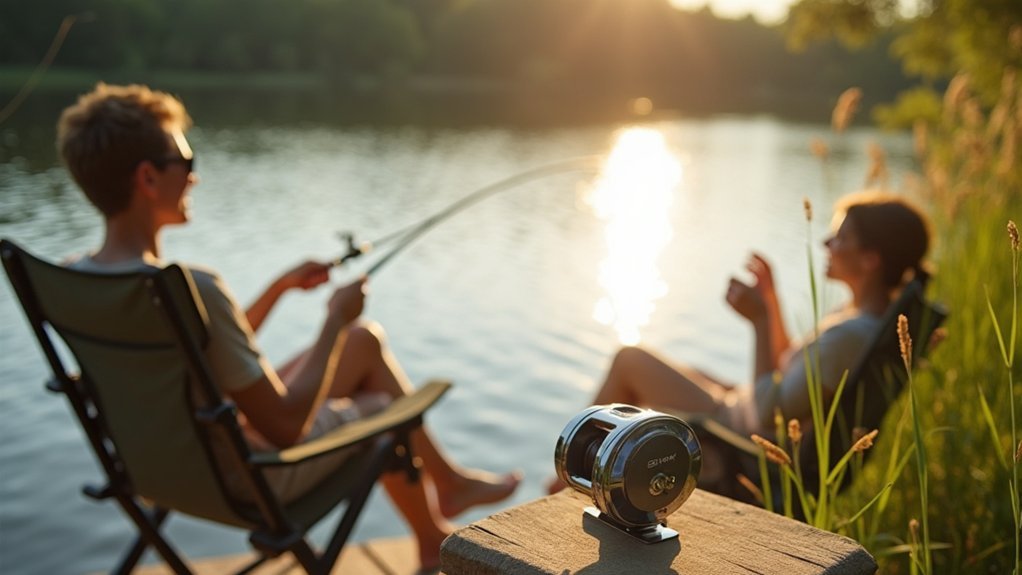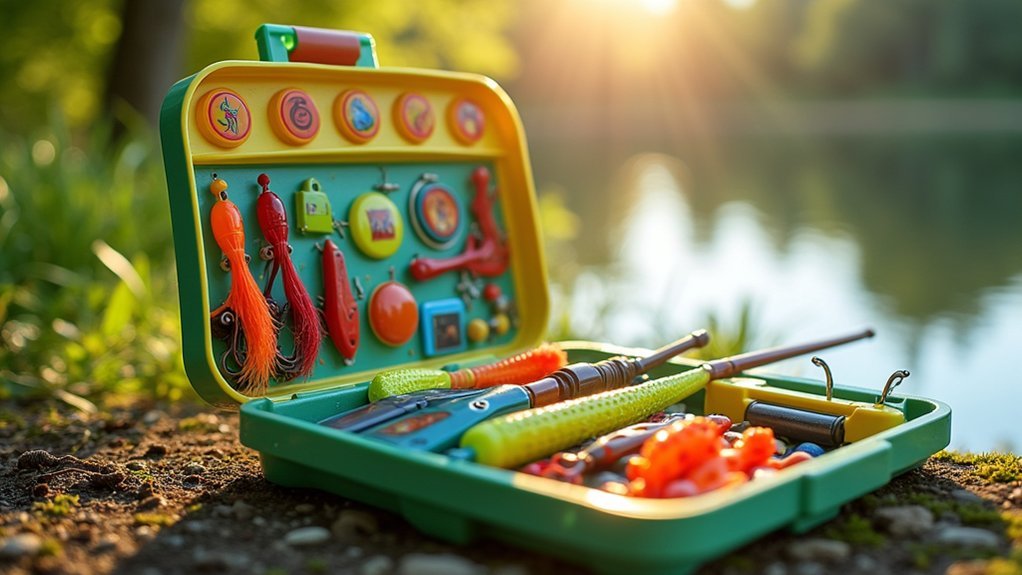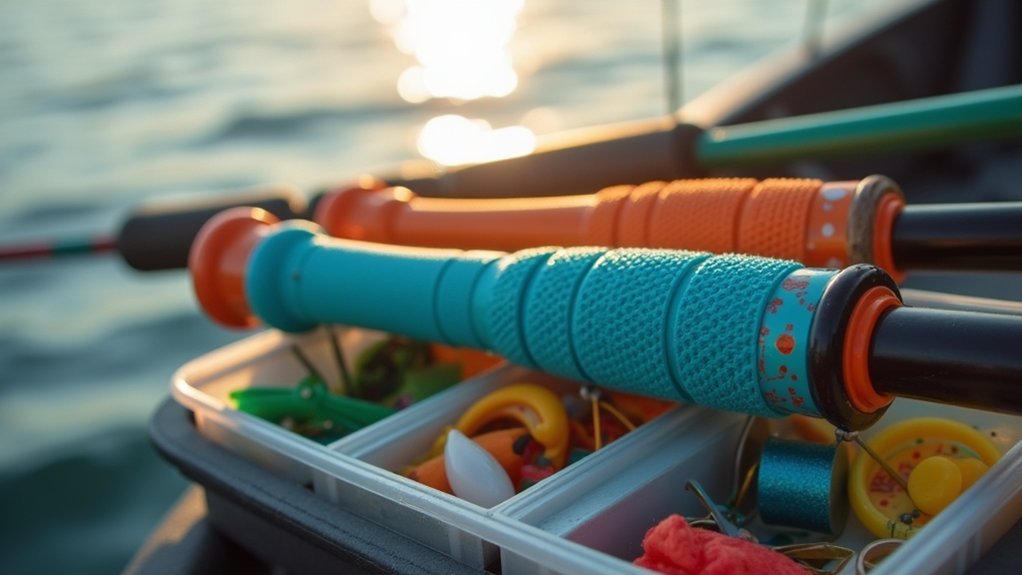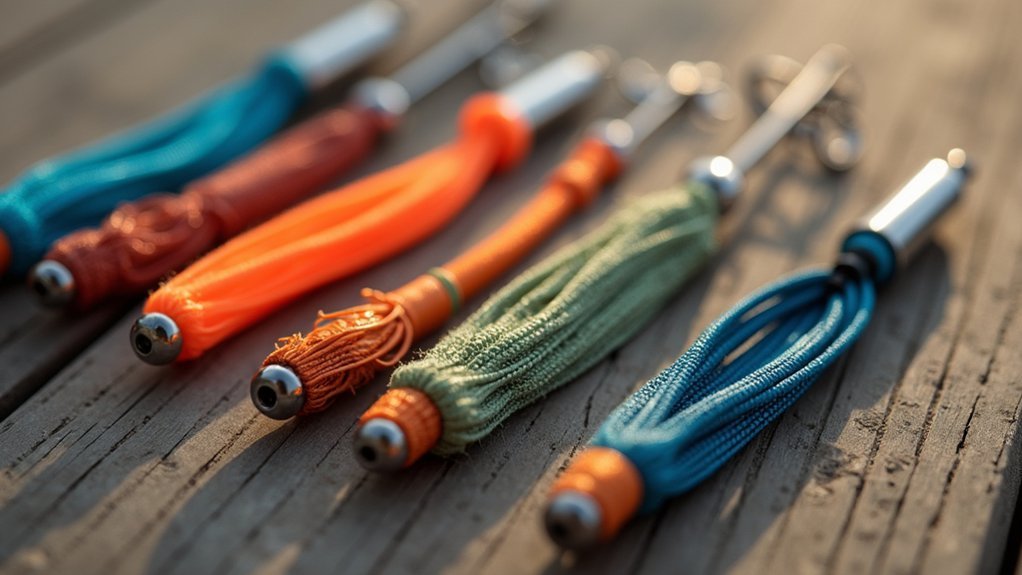For anglers with cognitive disabilities, you’ll find great success with push-button electric reels, color-coded tackle boxes, and picture-guide kits that simplify instructions. Consider one-step casting devices, no-knot fishing systems, and timer-based aids to maintain focus. Multi-sensory strike indicators, sensory-friendly grips, and routine-supporting equipment stations also enhance the experience. These adaptive options remove barriers, letting you focus on the joy of fishing rather than equipment challenges. The perfect gear awaits below.
Simple Push-Button Electric Reels for Easier Operation

When traditional fishing reels present challenges for anglers with cognitive disabilities, push-button electric reels offer a game-changing solution.
These specialized reels feature large, soft-touch buttons that eliminate complex manipulation and enable one-handed operation for those with limited dexterity.
The lightweight, cordless design reduces physical strain while increasing mobility. You’ll appreciate the simplified control scheme that minimizes confusion—just press a button to cast or retrieve. This automation dramatically reduces the learning curve and required steps for successful fishing.
Most models use integrated rechargeable lithium batteries that provide hours of use without frequent recharging. The FISH WINCH EZ delivers approximately 240 minutes runtime under no-load conditions when using recommended lithium batteries.
For enhanced accessibility, you can pair these reels with adaptive rod holders or knot tyers. Options like the FISH WINCH® EZ ($379) provide customizable settings to match your specific capabilities.
Color-Coded Fishing Tackle Organization Systems
You’ll find color-coded tackle systems serve as powerful visual memory aids for anyone with cognitive disabilities.
These organization methods use distinct colors to identify different lure types, bait categories, and fishing techniques, reducing the mental effort needed to locate specific items.
Clear compartments with consistent color schemes create simplified systems that make fishing more accessible by turning complex tackle management into intuitive, manageable choices. The four-color system with white for lead-based baits, orange for topwater, green for hard baits, and blue for soft plastics provides a streamlined packing approach that significantly benefits those with cognitive challenges.
Visual Memory Aids
For anglers with cognitive disabilities, color-coded organization systems serve as powerful visual memory aids that transform fishing from a potentially frustrating experience into an accessible and enjoyable activity.
You’ll find clear containers essential for quick visual identification. Try using colored stickers to categorize lures by type, weight, or fishing technique. Maintain consistent placement—always store specific tackle in the same color-coded location to reinforce memory patterns and reduce cognitive load. Hogy’s color-coded options provide excellent organization solutions specifically designed with anglers’ needs in mind.
Consider implementing tactile markings alongside colors for enhanced recognition. Technique-based organization (grouping baits used for similar purposes) provides additional context cues.
The benefits extend beyond organization—you’ll experience reduced stress, improved focus on fishing rather than searching for gear, and the ability to adapt quickly to changing conditions on the water.
Simplified Compartment Systems
Simplified compartment systems represent the backbone of effective fishing gear organization for those with cognitive disabilities. You’ll benefit from color-coded tackle boxes that separate gear by type, reducing search time and cognitive load. Daiwa’s storage solutions include patented box systems that prevent hook tangling while keeping baits securely in place with foam stabilizers.
| Box Color | Contents | Benefits | Best For |
|---|---|---|---|
| Red | Hard Baits | Quick visual ID | Memory issues |
| Blue | Soft Plastics | Reduced confusion | Processing challenges |
| Green | Topwater Lures | Immediate recognition | Attention limitations |
| Yellow | Terminal Tackle | Prevents mixing | Organizational difficulties |
Choose transparent boxes for easy visual scanning, and consider multi-colored storage pouches with ergonomic features for dexterity support. Using distinct-sized containers provides additional tactile cues beyond color. For terminal tackle (hooks, weights, swivels), small color-coded compartments prevent frustrating tangles while fishing in challenging weather conditions.
Picture-Guide Fishing Kits With Visual Instructions

Picture-guide fishing kits with visual instructions offer essential support for anglers with cognitive disabilities through intuitive visual step cards that clearly demonstrate each fishing procedure.
You’ll find color-coded tackle boxes simplify equipment selection, allowing you to match components by color rather than reading complex text. The Rexfly Casting System provides accessible options specifically designed for individuals with limited hand use.
These kits typically include pictorial safety guidelines that use straightforward imagery to communicate important precautions like proper hook handling and water safety protocols.
Visual Step Cards
When cognitive disabilities present challenges in learning complex tasks, visual step cards offer an elegant solution for fishing enthusiasts. These cards break down fishing activities into clear, sequential images with minimal text, making complex procedures accessible.
You’ll find these visual aids particularly effective for individuals who process information visually. While fishing-specific step cards aren’t widely available commercially, you can develop customized versions by consulting with both fishing experts and disability specialists.
The best visual step cards feature large, clear images, simple instructions, and durable, water-resistant materials. Consider integrating them with adaptive fishing equipment for a thorough approach. Social media platforms like Facebook and forums can help connect families seeking advice on creating effective visual guides for specific cognitive needs.
When designing or selecting cards, verify they’re adaptable to different cognitive levels and include all essential fishing steps from setup to catch-and-release techniques.
Color-Coded Tackle Boxes
Color-coded tackle boxes represent a powerful organizational strategy that builds upon the visual learning approach. By assigning distinct colors to each box, you’ll quickly identify and access your fishing gear without confusion or frustration.
These specialized boxes help you categorize tackle by type—lead-based baits in one color, topwater lures in another—reducing cognitive load while you’re on the water. You won’t waste time searching for equipment, allowing you to focus on fishing instead. The Bait Vault Camouflage Tackle Boxes feature adjustable dividers that create flexible storage options suitable for organizing various fishing accessories.
For enhanced accessibility, combine color coding with clear compartments so you can see contents directly. Adding picture guides provides step-by-step visual instructions without requiring extensive text comprehension. This system decreases dependency on written instructions while supporting memory recall through consistent visual cues.
The color-coding approach works exceptionally well when maintained consistently across all your fishing equipment.
Pictorial Safety Guidelines
Visual safety guidelines form the backbone of accessible fishing experiences for individuals with cognitive disabilities.
These step-by-step pictorial guides eliminate barriers by reducing reliance on complex text instructions, making fishing safer and more enjoyable.
When selecting fishing kits with visual instructions, look for:
- Large, clear images with minimal text showing rod assembly, baiting, and casting
- Consistent symbols (arrows, checkmarks, warning icons) to differentiate safe vs. unsafe actions
- Bright, contrasting colors that enhance recognition and understanding
- Emergency procedure illustrations for hook injuries or water safety
- Visual reminders for environmental hazards like sun protection
These visual aids support memory retention through image repetition rather than text, enabling independence and boosting confidence for anglers with diverse cognitive abilities while greatly reducing accident risks during fishing activities. Similar to the Connect Kits approach, these visual fishing resources help caregivers create meaningful engagement opportunities through shared outdoor activities.
Sensory-Friendly Rod Grips and Handles

Many anglers with cognitive disabilities benefit tremendously from specially designed rod grips and handles that address their unique sensory needs.
These adaptive handles feature ergonomic shapes and textured surfaces that enhance grip while providing essential tactile feedback.
You’ll find options with various materials to match your specific sensory preferences—cork offers warmth and comfort, while rubberized coatings prevent slipping in wet conditions.
Some handles incorporate weighted or vibration elements that provide additional sensory input during use.
Look for designs with simplified mechanisms and visual aids like color-coding that reduce confusion.
The best rods include adjustable features allowing you to customize length, angle, and grip size.
The Strong Arm Rod Holder made of durable leather provides excellent support for users with limited grip strength while offering comfortable sensory feedback.
Built-in stabilizers such as clamps or magnetic holders can reduce hand strain while giving you more confidence and independence on the water.
One-Step Casting Devices With Built-In Safety Features
One-step casting devices revolutionize fishing accessibility by condensing the complex multi-step process into a single motion that’s intuitive and user-friendly.
These devices typically feature gravity-sensitive controls that prevent accidental releases until the rod reaches a proper casting angle—usually 45 degrees or more.
You’ll find these devices particularly beneficial if you or your loved one has cognitive disabilities, as they promote independence while maintaining safety. The spring-loaded mechanisms securely hold the line until you’re ready to cast. Similar to professional setups, these adaptive devices emphasize the importance of investing in a quality reel over rod for reliable performance.
- Telescoping rods made from durable fiberglass or metal
- Spring-loaded release systems for effortless casting
- Gravity-sensitive controls that prevent mishaps
- Clear indicators showing when the rod is at the ideal casting angle
- Integration options with adaptive mounts for hands-free fishing
Memory Aid Fishing Apps and Waterproof Instruction Cards

Memory aid fishing apps with visual cues help you track your gear and remember fishing techniques through adaptive interfaces that accommodate cognitive disabilities.
Waterproof instruction cards offer durable, step-by-step visual guides that won’t be damaged when they inevitably get wet during your fishing trips.
Voice command technology integrated into these tools lets you access information hands-free, making the fishing experience more accessible and enjoyable while reducing cognitive load. These apps can be designed with evidence-based information similar to The Problem Solve It app, ensuring they effectively address functional cognitive skills needed for fishing activities.
Visual Cue Applications
Two key tools can greatly enhance the fishing experience for individuals with cognitive disabilities: specialized memory aid apps and waterproof instruction cards.
While specific fishing apps for cognitive challenges remain limited, you can adapt general memory aids for your angling adventures.
Waterproof instruction cards with visual diagrams provide durable, accessible guidance even in wet conditions.
Consider combining digital tools with physical aids for thorough support. Photography features with date and location stamps can help anglers document their successful fishing spots for future trips.
- QR codes on waterproof cards can link to instructional fishing videos
- Tablets in waterproof cases make excellent companions to printed materials
- Customizable apps help establish fishing routines and reminders
- Visual diagrams reduce reliance on complex verbal instructions
- Cards organized by specific tasks simplify the fishing process
The best solutions are adaptable to your individual needs and fishing style.
Step-by-Step Guide Cards
Designed specifically for anglers with cognitive disabilities, step-by-step guide cards transform complex fishing procedures into manageable sequences.
These waterproof, laminated cards pair simple language with visual icons to improve comprehension and memory retention while maintaining durability during outdoor use.
You’ll find these cards sized for easy handling and portability in your tackle box. High-contrast colors support those with visual processing difficulties, while the modular design allows customization to your skill level. Similar to Portable Therapy Kits, these fishing guide cards can be taken anywhere and used on-the-go without professional supervision.
For a digital alternative, memory aid fishing apps offer interactive elements with voice feedback and customizable alerts. They work offline—essential for remote fishing spots—and include simple animations to clarify techniques.
Both options increase your independence, enhance safety, and break fishing tasks into achievable steps while reducing cognitive overload.
Voice Command Technology
Modern voice command technology has revolutionized fishing accessibility for those with cognitive challenges. These systems allow you to navigate fishing apps, set reminders, and access safety features simply by speaking commands.
- Fishbrain and similar apps provide location-specific fishing information through voice prompts.
- Voice commands help you record successful fishing spots and techniques without writing.
- Safety alerts remind you of important precautions during your fishing trip.
- Waterproof instruction cards complement voice technology as visual backup.
- Community insights are accessible by voice, connecting you with fellow anglers’ tips.
The social networking aspect of these apps enables users to gain valuable fishing techniques from experienced anglers without the cognitive burden of extensive research.
Pre-Tied Rigs and No-Knot Fishing Systems

For anglers with cognitive disabilities, fishing preparation can often present considerable challenges that detract from the enjoyment of the activity itself. Pre-tied rigs offer an elegant solution, eliminating the need for complex knot-tying while ensuring ideal performance on the water.
These ready-to-use setups greatly reduce cognitive load, allowing you to focus on the fishing experience rather than equipment assembly. Similarly, no-knot systems provide adaptability for those with limited dexterity, making the entire process more accessible and less stressful.
When paired with adaptive gear like electric reels and rod holders, these simplified systems enhance your overall experience. Many participants report that fishing helps in reducing stress and anxiety by promoting relaxation and mindfulness. You’ll spend less time worrying about setup and more time developing actual fishing skills, fostering greater independence and enjoyment during your time on the water.
Timer-Based Fishing Aids for Attention Management
Timer-based fishing aids address another challenge many anglers with cognitive disabilities face: maintaining attention and focus throughout a fishing session.
Timer tools provide essential structure for anglers with cognitive disabilities, helping them maintain focus during fishing activities.
These tools create structured intervals that help manage concentration while making fishing more engaging. Some switch-adapted fishing games include features that activate fish movement when an external switch is pressed, providing immediate feedback to users.
Available in various formats to suit different needs, these aids can transform your fishing experience:
- Visual timers with color-coded displays help track fishing periods visually
- Auditory alert systems that signal when to check lines or change locations
- Mobile apps with customizable fishing timers and achievement tracking
- Physical countdown devices with large, easy-to-read displays
- Combination timers offering both visual and sound cues for thorough support
Multi-Sensory Strike Indicators (Lights and Sounds)
Detection barriers in traditional fishing can frustrate anglers with cognitive disabilities, but multi-sensory strike indicators offer a revolutionary solution.
These innovative tools combine bright visual cues, sound-emitting technology, and tactile feedback to guarantee you never miss a bite.
You’ll find these indicators particularly helpful if you struggle with attention or sensory processing issues. The combination of lights flashing, sounds alerting, and physical vibrations creates a thorough notification system that engages multiple senses simultaneously.
Many models offer adjustable sensitivity and customizable features to match your specific needs. Organizations like Oros Fly Fishing lead the industry with their patent-protected designs that combine accessibility with performance.
Made from biodegradable and natural materials like cork, today’s multi-sensory indicators are environmentally friendly while providing superior performance.
They’ll enhance your independence on the water while reducing stress and improving focus during your fishing experience.
Routine-Supporting Fishing Equipment Stations
Creating structure for anglers with cognitive disabilities, routine-supporting fishing equipment stations dramatically reduce the mental load of managing gear and techniques.
These specialized setups transform fishing from a potentially overwhelming activity into an accessible and enjoyable experience.
Adaptive fishing stations convert complexity to simplicity, making the joy of angling available to everyone.
- Fishing rod mounts secure equipment to boats, wheelchairs, or stable objects, freeing hands and reducing coordination demands.
- Electric fishing reels simplify casting and retrieval with button-controlled operation, eliminating complex manual manipulation.
- Knot tying devices automate the challenging process of threading hooks and securing line.
- Rod holders provide stability and support, reducing the need for continuous manual positioning.
- Motorized reels minimize physical effort required to bring in catches, allowing focus on the enjoyment rather than the mechanics.
These stations also contribute significantly to mental health benefits by providing a structured outdoor activity that reduces anxiety through clear organization and predictable processes.
Frequently Asked Questions
How Can Fishing Help Improve Cognitive Function?
Fishing can boost your cognitive function through omega-3 fatty acids in fish that reduce inflammation and preserve brain structures. You’ll improve memory and lower your risk of cognitive impairment with regular fish consumption.
What Safety Precautions Are Needed for Anglers With Cognitive Disabilities?
You’ll need constant supervision, life jackets, simple equipment with safety features, clear instructions, and a familiar fishing spot. Always fish in groups and establish recognizable emergency signals for immediate assistance.
Are There Fishing Communities Specifically for People With Cognitive Challenges?
Yes, you’ll find specialized fishing communities through organizations like Cast for Kids, Fishing Has No Boundaries, and Special Olympics. These groups offer adaptive programs, regular events, and supportive environments tailored specifically for people with cognitive challenges.
Can Cognitive Adaptive Fishing Equipment Work Alongside Physical Disability Aids?
Yes, cognitive adaptive fishing equipment works seamlessly with physical disability aids. You’ll find motorized reels complement cognitive support tools, while bite alerts with lights and sounds help those with sensory processing challenges and physical limitations.
What Funding Options Exist for Adaptive Fishing Equipment Purchases?
You’ll find funding through disability-focused foundations, government assistance programs, veteran services, private organizations’ grants, and community fundraising. Apply early for these opportunities, as they can cover various adaptive fishing equipment costs.
In Summary
You’ll find that fishing doesn’t have to be complicated with the right adaptive gear. Whether you’re using a push-button reel or enjoying visual guides, these tools open up the joy of fishing for everyone. Don’t hesitate to try different options until you find what works best for your needs. With these accessible solutions, you’re all set to create memorable experiences on the water.





Leave a Reply